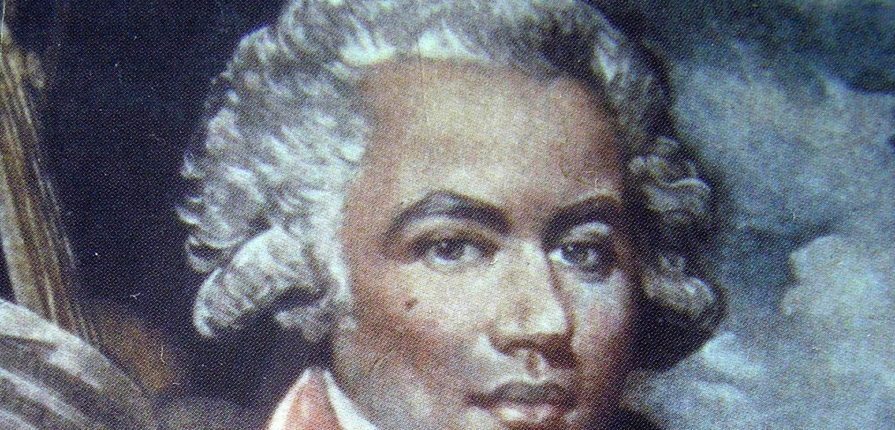by Andra Prewett
Joseph Bologne (1745-1799), known as Le Chevalier de Saint-Georges, was a bit of a rockstar during his time. Born on the Caribbean island of Guadeloupe, his father was a plantation owner, and his mother was a slave. At age seven, he and his father moved to Paris. There he began fencing lessons and showed promising talent in the sport. As a teenager, Bologne gained great fame by defeating the champion swordsman, Alexandre Picard, in a duel. King Louis XVI was so impressed that he appointed Bologne to the king’s bodyguard, eventually knighting him, which is how he became known by his title, the Le Chevalier de Saint-Georges (chevalier means “knight” in french).
Saint-Georges was also quite an accomplished violinist. He was concertmaster of the well-respected Le Concert des Amateurs under the direction of François Gossec (yes, THAT Gossec, the composer of Gavotte in Suzuki Violin Volume 1 and Cello Volume 2). Under Gossec’s tutelage, he began composing symphonic works for the orchestra to play. He ultimately became conductor of the orchestra, enchanting Parisians with his compositions and his stage presence, “enrapturing especially the feminine members of his audience.”1 He also served as Marie Antoinette’s private music tutor, but was ultimately fired for getting “too close” to the queen.2
If he was so famous, why haven’t we heard of him? There are multiple reasons, and race was certainly a factor. During his lifetime, he was passed over for the prominent position of director of the Paris Opera, as several singers refused to take orders from a man of mixed race. But it seems that the French Revolution, which happened at the end of his life, is the main reason for his forgotten legacy. Despite his close ties to the king’s court, he served as colonel in the French Revolution, in Europe’s first all-black regiment. History is unclear as to the reason, but he was incarcerated without charge in 1793 for 13 months during the Reign of Terror and narrowly escaped the guillotine. When he was finally released, the Paris he knew was gone, and much of his music was lost. Without the court’s financial backing and army salary, he lived a much lower profile life in his remaining years.
In recent years, his works were rediscovered by several music historians. He has gained some notoriety in classical music circles and has been called the “Black Mozart,” but this is not a fair comparison. Saint-Georges was eleven years older than Mozart, and was much more well known at the time.3 Saint-Georges is also credited with being one of the first to compose the symphonie concertante, a musical form that is a hybrid of the double concerto and a symphony. By comparison, Mozart wrote his Sinfonia Concertante four years after the premier of Saint-Georges’. Saint-Georges was a fine composer in his own right, and his music should stand alone without comparison.
Violinist Rachel Barton Pine has done a wonderful service to the classical community by including works by Saint-Georges, along with other black composers, in her book “Music by Black Composers.” In addition to the volume being a perfectly suitable supplement for Suzuki students playing at the Books 1-4 levels, it is extremely well put together. Each piece has an easy to understand bio of the composer, plus performer spotlights of accomplished young black violinists. Each book includes a piano accompaniment AND a 2nd violin accompaniment part, making it possible for a more advanced sibling or teacher to provide accompaniment. And best of all, video recordings of each piece are easy to view on youtube. Check out the Music by Black Composers’ website: https://www.musicbyblackcomposers.org/
You can purchase a copy of Music By Black Composers through:
Sorry violists and cellists, the viola and cello volumes have not yet been released!
Citations:
- Prod’homme, Jacques-Gabriel (1949). François Gossec, la vie, les oeuvres, l’homme et l’artiste (in French). Paris: La Colombe.
- Waliek, Gary (2019) ‘Le Chevalier De Saint-Georges: Fencer, Composer, Revolutionary’, WBUR <accessed 28 August 2020> https://www.wbur.org/onlyagame/2019/03/15/chevalier-saint-georges-france-fencing
- Duchen, Jessica (2016). Chevalier De Saint-Georges: The man who got under Mozart’s skin, Independent <accessed 28 August 2020> https://www.independent.co.uk/arts-entertainment/classical/features/chevalier-de-saint-georges-man-who-got-under-mozart-s-skin-a6859191.html
General References:
- https://www.independent.co.uk/arts-entertainment/classical/features/chevalier-de-saint-georges-the-man-who-got-under-mozarts-skin-a6859191.html
- https://www.wqxr.org/story/chevalier-de-saint-georges-jack-all-trades-and-master-all-them/
- https://chevalierdesaintgeorges.homestead.com/Page1.html
- https://www.wbur.org/onlyagame/2019/03/15/chevalier-saint-georges-france-fencing
- Composer Profile: Joseph Bologne, Chevalier de Saint-Georges, Composer of Six Operas

